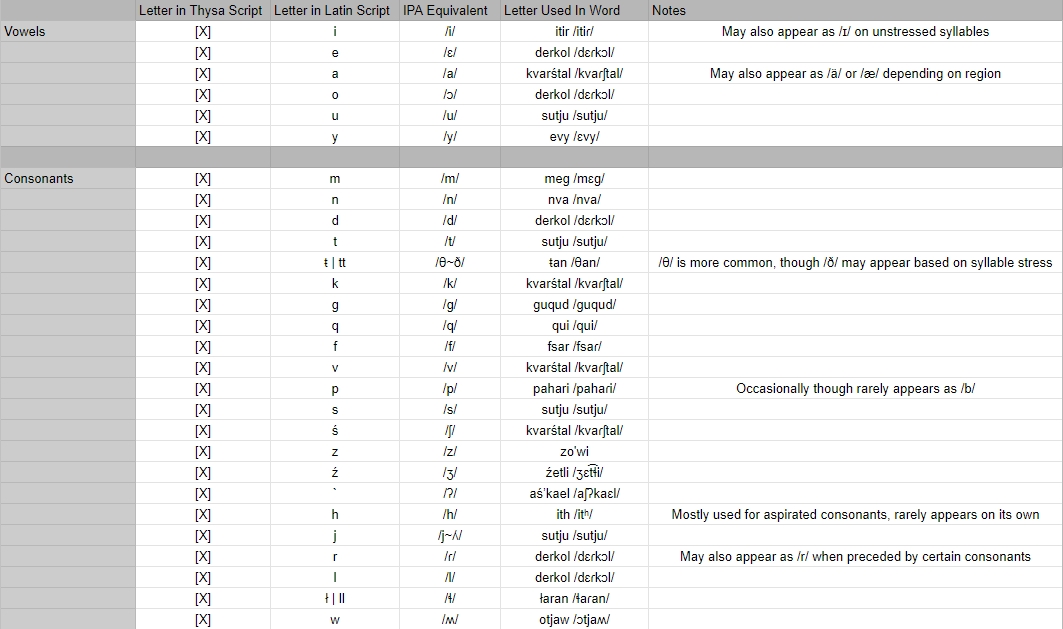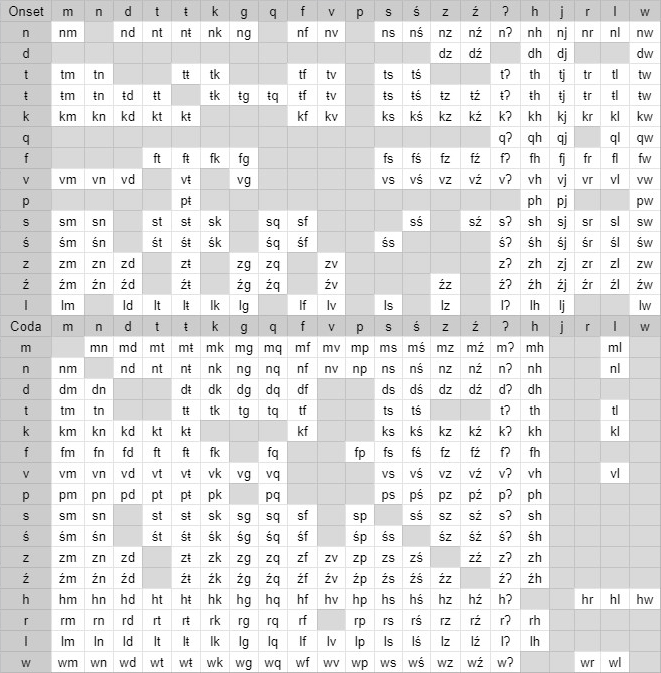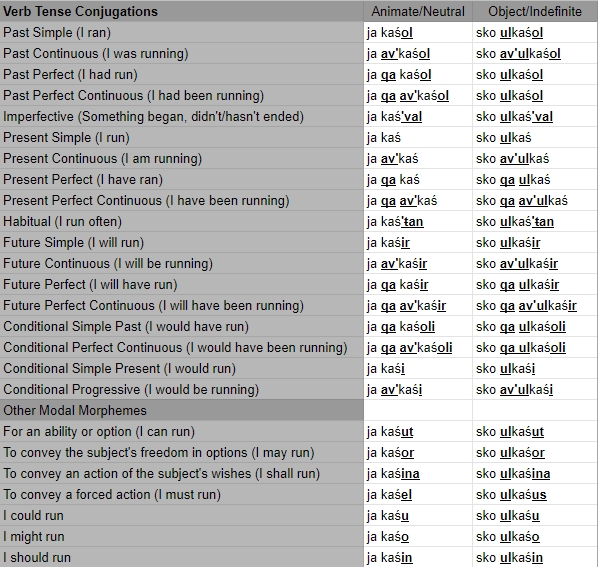Vosqod
Vosqod (/vɔs'qɔd/) is the largest member of the Ivskanic language branch. Native to the Einaseran peoples of central Ivskia, it is the continent's lingua franca for trade and the second most-spoken language across the world, after Durranian.
Phonology
Consonant Clustering
The consonants /ʔ/, /h/, /j/, and /w/ cannot cluster at the intial onset of a syllable. The consonants /m/, /g/, /p/, /h/, /ɾ~r/, and /w/ cannot cluster at the initial onset of a syllable save for the cases of added aspiration (/mʰ/, /gʰ/, /pʰ/, /ɾʰ~rʰ/, /wʰ~hʷ~ʍ/), palatalization (/mʲ/, /gʲ/, /pʲ/, /hʲ~ç/ /ɾʲ~rʲ/), or labialization (/mʷ/, /gʷ/, /pʷ/, /wʰ~hʷ~ʍ/). The consonants /ʔ/, /j/ cannot cluster at the initial coda of a syllable. The consonants /θ~ð/, /g/, and /q/ cannot cluster at the initial coda of a syllable save for the cases of added aspiration (/θʰ~ðʰ/, /gʰ/, /qʰ/) or with a postpositional glottal stop (/θʔ~ðʔ/, /gʔ/, /qʔ/) Vosqod follows a (C)(C)V(C)(C) pattern, though single-letter words are very rare.Morphology
Case Morphology
Vosqod has a total of 14 grammatical cases which it inflects solely on nouns. The possessive case is largely obsolete and rarely used in common speech; ownership in such situations is noted through word order and use of the genetive case alone rather than both in tandem. Traditional Vosqod employs the use of both cases in agreement and allows for freer word order. In the modern era, the possessive case is most often employed in declarative or comparative statements (e.g. qosur ŧuranak av, tos-vek! "This is their house, not yours!"). The recently emergent personal possessive case, which supersedes the personal pronoun entirely via inflection onto the owned object (e.g. ŧuranakaya av, tos-vek! "This is my house, not yours!" has lead to further obsolescence. Additional suffixes can be added to any of the locative cases to inflect for direction with the following method: y|above u|below a|before/in front o|behind. Thereby "ja tosys ŧuranadi vwatku'ir" would become "I will meet you above/atop the house." The elative case that formerly existed within the language fell out of use, and the modern language instead adds a negation particle to the end of a noun inflected for the illative and inessive cases to indicate motion or status outside of something. So "I am going out of the house" would be "ja ŧuranir-vek av'liksi."Verb Morphology
Syntax
The [X] and [X] letters (represented in Latin script by a hyphen and apostrophe, respectively) are only used in word combinations. [X] (the hyphen) represents concepts married to the core word while [X] (the apostrophe) is used for modifications to the action of the core word such as in the case of turning it to a proper noun or to indicate habitual case.
As an example which combines both, the term "ulkaś'ŧan-idju" is a Vosqod insult roughly equivalent in meaning to the English term "pansy" and similar which would directly translate to something like "it which does often run away". Stemming from the root word kaś /kaʃ/ meaning "run", the ul prefix is added to change it to an objective noun for the purpose of insulting. From there, the 'ŧan suffix is added using [X] as a bridge to show that it is modifying the verb and changing it to the habitual case: "ulkaś'ŧan" would roughly mean "it which runs often". The second suffix of -idju (which would roughly translate to "to act" or "to do") is then added with [X] to show that it is not directly modifying the core word but the way in which it is done - in this case, to hint that the habitual verb is being done at that very moment.
A/o often represent opposites.
Word Order
Thysa uses SOV (Subject-Object-Verb, "she him loves") word order. It's Adjective Noun order is AN, the same as English (e.g. "red chair").Demonstratives/Determiners
Thysa has no independent demonstratives (a/the/that) - instead, numbered amounts are used in their place, and the prefix q' is added for definites. "A light" would be "jaź krita" while "The Light" (typically referring to the god itaru or the sun) would be "Q'krita". If referencing a specific object as in the case of "that spear", a specific number would be used: "yn otjaw". Jaź is an article used in Vosqod to denote an object, similar to the English article(s) 'a/an'. Unlike these, jaź can also serve as a sentence particle denoting amounts of things or shifting in numbers when paired with other postpositional particles. Jaźa and jaźo thereby mean 'more' and 'less/fewer' (in corroboration with Vosqod's general pattern of -a/-o postpositions to denote positive and negative shifts in various concepts) while its dual form of jaźi effectively means "any". Combinations of these such as jaźani or jaźoni can be formed to create "anymore" and "any less/fewer" respectively. The paucal and plural forms - jaźaw and jaźek - function as terms roughly equating to "a few" and "many", respectively.Phonetics
When preceded by a /t/, the letter l /l/ is always morphed into /ɬ/ to form the /t͡ɬ/ affricate, such as in the case of tletnir /t͡ɬetnɪɾ/, meaning "ape".
Other consonants and affricates present but not directly represented via the alphabet are /ɲ/, /ŋ/, /t͡s/, /t͡ʃ/, /d͡z/, and /d͡ʒ~d͡ʑ/ via the letter combinations nj, ng, ts, tz, ds, and dz respectively.
The monophthongs /e/, /ə/ may appear depending on regional accent and unstressed vowels, but are not officially recognized sounds in the alphabet.
All possible diphthongs are allowed.







Comments